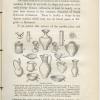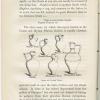Drawing of pottery vessels
Commentary
Drawings in ink by Arthur Evans of nine variously shaped pots or vessels, titled ‘Croatian Crockery’, identified as depictions of pottery for sale at the market in Zagreb, Croatia, with accompanying notes: ‘Went into crockery market to study crocks - the chief forms are a wine, beer, or water jug - called Péhá’.
Artist: Arthur John Evans
Date of drawing: August 1875
Continent: Europe
Geographical area: Southern Europe
Country: Croatia
Region/Place: Zagreb
Cultural group: European Croat
Format: Drawing
Size: 163 x 88 mm
Acquisition: Joan Evans. Donated August 1941
***
Exhibition caption: ‘One of a selection of drawings and ink sketches made by Arthur Evans while travelling with his brother through Bosnia and Herzegovina in the summer of 1875. They show people and places encountered by the pair on a route south from Agram (modern-day Zagreb) – via Tešanj, Sarajevo and Mostar – to Ragusa (Dubrovnik), which Evans and his wife were later to make their home. The illustrations demonstrate a particular interest in identity and dress, Evans writing, for example, of finding “two Bulgarians hard at work tying up bundles of onions, clad in their dark national costume – the brown tight-sleeved jacket embroidered with black, the dull red sash, the brown trowser-leggings which are equally Turkish and Tartar and on their head the black sheepskin cap which had at first attracted my attention.” As well as being an aide-mémoire, the drawings provided the basis for engravings published in Evans’ account of his journey, Through Bosnia and the Herzegóvina on Foot during the Insurrection, August and September 1875 (London, 1876). As an eyewitness account of a distant region in turmoil, the book was an immediate success, quoted extensively in Parliament, and it went into a second edition the following year.’ Source: ‘Travels in Finland and Bosnia-Herzegovina: An Ethnographic Collection of Sir Arthur Evans’, exhibition curated by Philip Grover, Pitt Rivers Museum, University of Oxford, 29 April to 1 September 2013.
Primary documentation: ‘[p.588] Dr. JOAN EVANS, from the property of the late SIR ARTHUR EVANS, Youlbury, Boars Hill, Oxford. [List of items follows]’; ‘[p.590] 21 Original pencil sketches, types & scenery. BALKANS’: Pitt Rivers Museum accession records (Donations X, 1937–1941), pp.588, 590. Annotations on drawing: ‘Croatian Crockery./ Went into Crockery market to study crocks - the chief forms are a Wine, beer, or water jug - called Péhá./ In the Museum were several other forms - & a Roman Pitcher from Salona - curiously resembling the Stutza, though without the hollow-perforated handle wh[ich] some Stutzas have. One curious wooden water-barrel - a kind of [left blank]. Was called Baril. Very great general resemblance with crocks of Transylvanian, Roman, & Serb markets. There are also imitation [b]owls as in Scandinavia[.]/ In Museum were also some Croat silver earrings of filigree work. Indian character - & of strikingly Byzantine or Arabic forms - One reminded me extremely of some found in Denmark & Gothland. I saw a woman in market to-//[verso] day with some silver pendants on her heart. Others with several silver rings./ In the market I noticed a man in very dark clothes & black sheepskin conical cap. I recalled to min[d] the Bulgarians - & afterwards on coming back from Maximir Park I noticed a man in Croat tunic but with instead of the usual red - a black vest. The explanation is that a Bulgarian colony has settled two years ago at Maximir - tempted by cheapness & richness of the land & [word cut off] discontent. A German compares women here to sacks. I think on the contrary that their dress is often extremely graceful & they have an almost Zigeuner like power of putting themselves to picturesque attitudes. The beauty occasionally observable in Agram - very refreshing after the brutal ugliness of a German town I take to be Italian - I never remember see[ing] any really ugly costumes out of Germany’ (written in black ink surrounding drawings and continuing on verso of page).
Research notes: It has been identified by Philip Grover that parts of this original drawing were used as the artwork for two woodcut engravings subsequently published in Arthur J. Evans, Through Bosnia and the Herzegóvina on Foot during the Insurrection, August and September 1875 (London, 1876), p.18, printed with the caption ‘Roman and Croatian Pottery’, and p.19, printed with the caption ‘Croatian Pottery’. Evans recorded in the volume: ‘The same South Sclavonic unity is apparent if we examine pots and pans which these old-world peasants are selling in the market-place. [...] The other vessels to be found in the Croatian crockery-markets, if they do not betray Roman influences, at least in nearly every case bear witness to the common character of South Sclavonic civilisation. There is hardly a shape in the Agram market which may not be found again at Belgrade or Bucharest’: Through Bosnia and the Herzegóvina on Foot, pp.16, 19. Note that Agram is the German name for Zagreb, Croatia.


